How few corners can a shape have and still tile the plane?” mathematician Gábor Domokos asked me over pizza. His deceptively simple question was about the geometry of tilings, also called tessellations—arrangements of shapes, called tiles or cells, that fill a surface with no gaps or overlaps. Humans have a preoccupation with tessellation that dates back at least to ancient Sumer, where tilings featured prominently in architecture and art. But in all the centuries that thinkers have tinkered with tiles, no one seems to have seriously pondered whether there’s some limit to how few vertices—sharp corners where lines meet—the tiles of a tessellation can have. Until Domokos. Chasing tiles with ever fewer corners eventually led him and his small team to discover an entirely new type of shape.
It was the summer of 2023 when Domokos and I sat at a wood picnic table at the Black Dog, a cozy spot for pizza and wine just a few blocks from the Budapest University of Technology and Economics, where Domokos is a professor. He reached across the table to grab a paper pizza menu and flip it over, revealing a blank underside, and gestured to me to grab a pen. The midsummer sky was taking on shades of orange and indigo as I filled the menu with triangles. Domokos watched expectantly. “You’re allowed to use curves,” he finally said. I started filling the page with circles, which of course can’t fill space on their own. But Domokos lit up. “Oh, that’s interesting!” he said. “Keep going, you can mix shapes. Just try to keep the average number of corners as low as possible.”
I kept going. My page of circles filled with increasingly desperate, squiggly forms. Domokos’s pizza Margherita had long since disappeared, but he wasn’t quite ready to leave. A quick glance at my crude drawing wasn’t enough to determine its average number of corners, let alone the minimum possible. But the right answer must have been something less than the triangle’s three—otherwise, the question would be boring.
On supporting science journalism
If you’re enjoying this article, consider supporting our award-winning journalism by subscribing. By purchasing a subscription you are helping to ensure the future of impactful stories about the discoveries and ideas shaping our world today.
That observation seemed to satisfy the mathematician, who revealed that the real answer is two. “That’s an easy question,” he said. “But what about 3D?”
“This is a tool that can reasonably describe, at least to me, a wide range of more physically relevant things than just polyhedrons stuck together.” —Chaim Goodman-Strauss, mathematician
Now, more than a year after that evening at the pizza shop, Domokos has the answer. Finding it was an exciting, frustrating challenge that ultimately led him and three colleagues to discover “soft cells,” shapes that can fit together to completely fill a flat surface or a three-dimensional space with as few corners as possible. In two dimensions, soft cells have two corners bridged by curves. But in 3D, these curvy, almost organic forms have no corners at all. Once the researchers identified the new shapes, they began to see them all over the place—in nature, art and architecture. The results have now been published in the journal PNAS Nexus.
Although soft cells hadn’t been categorized by mathematicians before—no one had noticed or named them in an academic paper—they abound in art and nature, from the architecture of Zaha Hadid, “Queen of the Curve,” to the forms of zebra stripes. Krisztina Regős, Domokos’s graduate student, found the first natural 3D soft cell tucked away in the chambers of the nautilus shell, an object that’s become iconic for showcasing the convergence of math and biology. “They were in front of our eyes the whole time,” Regős says. This connection to such a famous shape led Domokos to fear that his group would be scooped. He swore his collaborators to secrecy until their discovery was ready to be published. (It came out in September.) At the end of his lesson over pizza, he even took the paper menu, folded it up and pocketed it. Just to be safe.
In retrospect, it should have been obvious that soft cells exist, says mathematician Joseph O’Rourke of Smith College, who wasn’t involved in the study. But to think to ask such a question, “to even imagine that you can tile space with no vertices,” he says, is original. “I found that quite surprising and very clever.”
“This is a tool that can reasonably describe, at least to me, a wide range of more physically relevant things than just polyhedrons stuck together,” says mathematician Chaim Goodman-Strauss of the University of Arkansas, an expert on tiling. “Just look at the foam in a glass of beer, and you’ll know they’re onto something.”
Years ago Domokos developed a mathematical tool for describing tessellations based on their average properties rather than the shapes of individual cells. The idea grew out of work on natural mosaics, such as cracked rock faces. Using averages captures the essence of the tessellation without imposing unnatural rigidity.
As Domokos and Regős explored the rules governing the average properties of mosaics, they realized something: it didn’t seem possible to get the average number of vertices (corners) per tile below two. From there it wasn’t much of a leap to realize that a monotile—a tile that fills the plane only with copies of itself, such as the regular hexagons of a honeycomb or squares of a checkerboard—couldn’t have fewer than two vertices. This rule hadn’t been recognized before.
When Domokos and Regős couldn’t find any previous work on the subject, the duo realized they had something interesting on their hands. But they felt out of their geometric depth when it came to translating their discovery into a formal mathematical rule. They recruited geometer Ákos G. Horváth, who also works at the Budapest University of Technology and Economics, to their cause.
Horváth soon devised an algorithm that could warp polygonal tilings of the plane into tilings of shapes with just two vertices. Using it, the team devised rounded, soft, two-vertex tiles from regular tilings of triangles, hexagons and rectangles. The hexagonal tiles they used look like hexagons that have had two corners stretched out and the rest ground down to rounded nubs. The square-derived tiles are more diverse. One looks like a deformed square, but the others resemble shingles, fish scales, lentils and the flukes of whales. The two types of tiles derived from triangles look a bit like a hill and a ship’s sail.
Then, Domokos says, “we started to fantasize about what it is in 3D.”
Jen Christiansen; Source: “Soft Cells and the Geometry of Seashells,” by Gábor Domokos, Alain Goriely, Ákos G. Horváth and Krisztina Regős; February 6, 2024; arXiv:2402.04190 (tile reference)
People have been imagining 3D tessellations at least since Plato’s time. He built his model of the universe around tessellations of the five regular convex solids: tetrahedron, cube, octahedron, icosahedron and dodecahedron. Tessellations of the first four shapes should build the classical elements of earth, air, water and fire, respectively, Plato figured. The dodecahedron was the stuff of the cosmos. Plato was wrong about more than this esoteric cosmology. Only the cube can actually fill 3D space as a monotile—with exact copies of one shape—without gaps and overlaps (unless the space itself is curved). But cubes squished and stretched into parallelepipeds (shapes with six parallelograms for faces) can fill space, too. And in 1885 Russian crystallographer Evgraf Fedorov cataloged a set of five shapes called the parallelohedra—3D forms that can be packed together without any rotation. These shapes include the cube and the hexagonal prism familiar from honeycombs, as well as the more esoteric rhombic dodecahedron, elongated dodecahedron and truncated octahedron.
All these shapes are polyhedra with flat faces and straight edges. But 3D shapes with curves can fill space, too—although the ready examples are only slightly bent and have obvious corners. Tellingly, the known examples all emerged from questions about nature, not abstract mathematics. In 1887 British mathematician William Thomson, also known as Lord Kelvin, posed a puzzle: What arrangement of cells or bubbles of equal volume minimizes the surface area of the interfaces between them? In other words, what is the optimal foam?
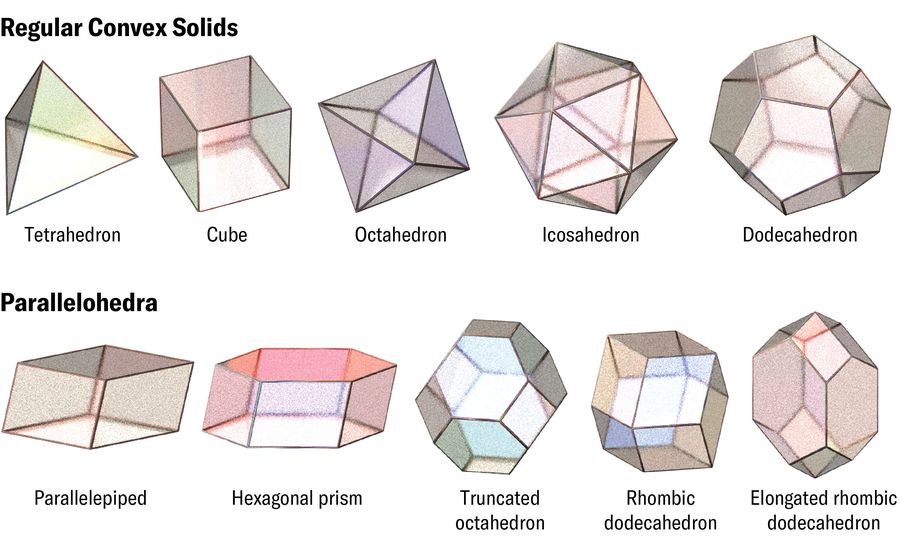
Kelvin’s first solution was a tessellation of slightly warped truncated octahedra. In a 1994 paper, physicists Denis Weaire and Robert Phelan, both then at Trinity College Dublin, beat Kelvin’s structure with a tessellation of two different warped polyhedra. And in 2018 a team of biophysicists led by Luis M. Escudero of the University of Seville and Javier Buceta of the Institute for Integrative Systems Biology in Spain discovered a new shape called a scutoid, resembling a warped honeycomb, which the body’s epithelial cells assume to pack optimally in tissues that need to bend and curve. Still, no one seems to have asked how few corners a space-filling solid can have. The Hungarian team’s leap to 3D was, at first, a leap of faith. “We had not the faintest idea. Not even a hunch,” Domokos says.

When the trio eventually identified a space-filling 3D shape with just two corners, Domokos thought they’d found their answer. “I got completely obsessed with this whole thing,” he says. “And I wrote a paper proving that the minimum number [of corners] in three dimensions is two.” The proof grew out of a simple assumption that Domokos thought was trivial. But as months came and went, he slowly started to realize that the assumption wasn’t so minor after all—and it might even be wrong. “He wanted to send this article to me and Ákos for Christmas. Then for New Year’s Eve. And then later and later,” Regős recalls, fighting back a grin. “And then he found an example with zero. So that was that.” The shape was itself a proof: in three dimensions, it is possible to tessellate space with objects that have no corners at all.
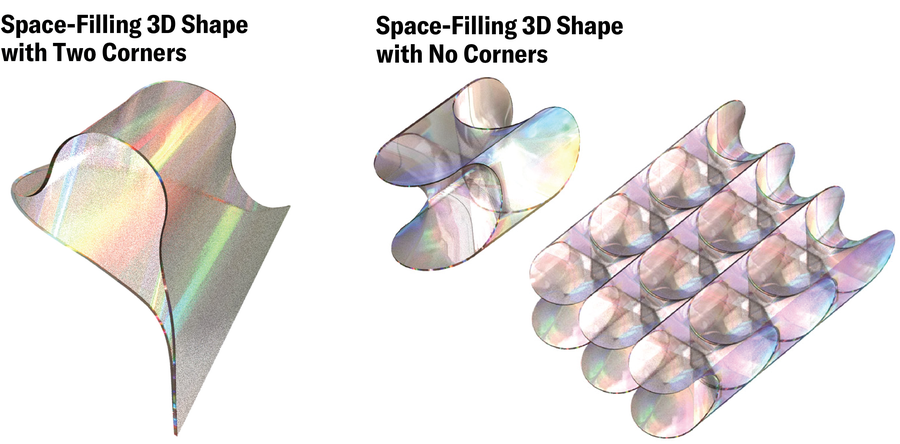
Violet Frances; Source: “Soft Cells and the Geometry of Seashells,” by Gábor Domokos, Alain Goriely, Ákos G. Horváth and Krisztina Regős; February 6, 2024; arXiv:2402.04190 (reference)
Finding that first soft cell answered one question and opened up countless more. The researchers wondered, for instance, whether space-filling shapes with exactly one corner could exist. Domokos eventually found one. When he sketched it out on a blackboard for Regős and Horváth, they were “disgusted,” he says. It was an ugly shape—a warped form with no symmetries that looks like something dreamed up by an alien. But somewhere in that ugliness, Regős glimpsed possibility. “I just saw it one day and realized,” she says. “We can do this edge-bending thing and create the softness.”
Regős’s intuition was that she could create soft cells by bending the edges of normal, pointed polyhedra. At each vertex where three edges met, she’d grab two edges and coerce them into curves that ran parallel to the remaining edge where the vertex was before. A closed solid in 3D space must enclose 4π degrees of curvature, which are usually concentrated at vertices. Regős was smearing out that curvature over edges instead. “It took days and days and days to convince me that what she’s doing is not completely rubbish,” Domokos says.
Regős had trouble describing her method for bending edges in mathematical language. But then she realized the process could be boiled down to an easily solved 2D problem from graph theory. Every polyhedron has a dual—another polyhedron whose faces correspond to its edges and vice versa. The team showed that if it’s possible to find a path along the edges of a polyhedron’s dual that visits each of its vertices exactly once—what’s called a Hamiltonian circuit—it’s also possible to warp that shape into a cornerless, space-filling soft cell.
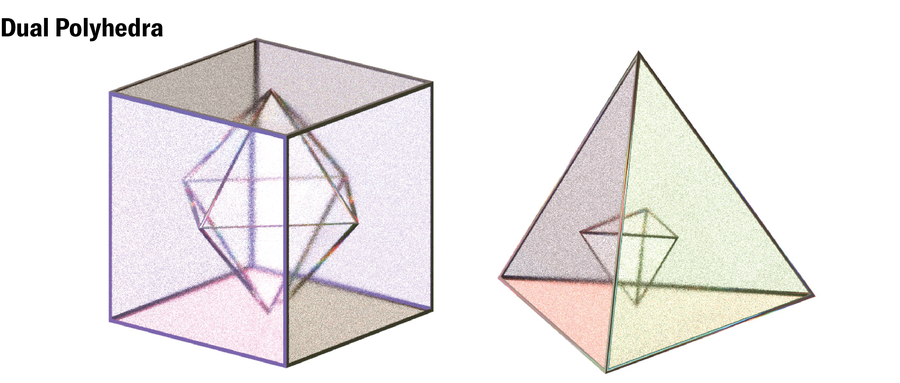
With that condition set, Horváth could finally write a mathematical 3D edge-bending algorithm. By mapping an infinite category of polyhedral tilings to soft tilings, he proved the existence of an infinite class of soft cells. In other words, for every polyhedron—a 3D shape with flat polygonal faces—that could fill space with itself, there must also be a curved soft cell.
To O’Rourke, the edge-bending algorithm is the most beautiful and significant part of the paper. The elegance comes from uniting two entirely different fields of mathematics. Hamiltonian circuits are purely combinatorial (having to do with the mathematics of counting)—they have “nothing to do with geometry,” O’Rourke explains. “But here you’re very much in geometry. And yet you need this combinatorial condition. So I find that very nice.”
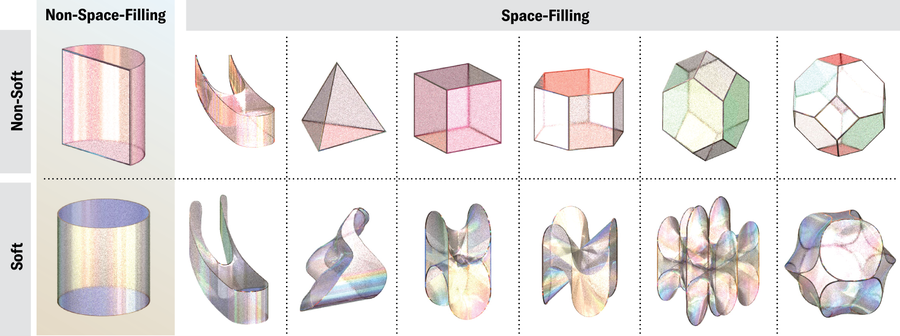
Violet Frances; Source: “Soft Cells and the Geometry of Seashells,” by Gábor Domokos, Alain Goriely, Ákos G. Horváth and Krisztina Regős; February 6, 2024; arXiv:2402.04190 (reference)
As they came to understand the mathematics of 2D soft cells, the mathematicians began to realize that the shapes existed beyond their sketches and notes. “They were right under our noses,” Domokos says. The team started to see planar mosaics of two-vertex tiles everywhere, from muscle tissue to zebra stripes. Once, on a walk through Budapest, Regős even saw them in the curvy crisscross of a metal safety grate.
At the same time, the trio was finding more and more 3D soft cells—Regős added warped versions of four parallelohedra, as well as tetrahedra, to Domokos’s first shape, a warped cube. But the researchers struggled to identify these 3D soft cells in the real world. That changed when, about a year after Domokos first found the edge-bent cube, he realized he’d seen it somewhere before—not in nature but in architecture.
About a decade earlier, architect Viki Sándor and a group of students at the University of Vienna had concocted an unusual design for a Cirque du Soleil performance center. The building was never constructed, but it got some attention in architectural circles. Its fundamental building block was a shape that looks almost exactly like Domokos’s cubic soft cell.
Sándor’s project started as a warm-up exercise around the theme of “balance,” says the architect, now at the Austrian Institute of Technology. The building had to be modular, so they divided it into cubic blocks, each to be designed by a different person. By coincidence, the design was inspired by a self-balancing shape called the gömböc, discovered in 2006 by Domokos and structural mechanics researcher Péter Várkonyi. Sándor and her teammates liked the gömböc’s contrast of thinness and fatness and wanted a similar shape that would fit different modules together. They found their answer in the C-shaped curves of a tennis ball. “If you cut along the C-shape, then you get a very thin and a very fat element. And the gömböc follows this principle,” Sándor says. Cutting curved surfaces into tubes or prisms turned out to be a good method for constructing soft cells—not just in theory or design but also in nature.
Regős found the first natural 3D soft cell in a flash of intuition. One day out of the blue she e-mailed Domokos a picture of a cross section of a nautilus shell. Domokos replied that it was a nice example of 2D soft cells. Regős wrote back: no, they were 3D soft cells. “It doesn’t look soft at all,” Domokos thought. “I mean, it has corners.” But Regős was insistent. So Domokos bought two nautilus shells and presented them to Regős and Horváth for inspection. They played with the shells for 30 minutes or so before giving up. Even if they could convince themselves just by looking at the shells, Domokos says, “you cannot send in a shell to a paper as an attachment.”
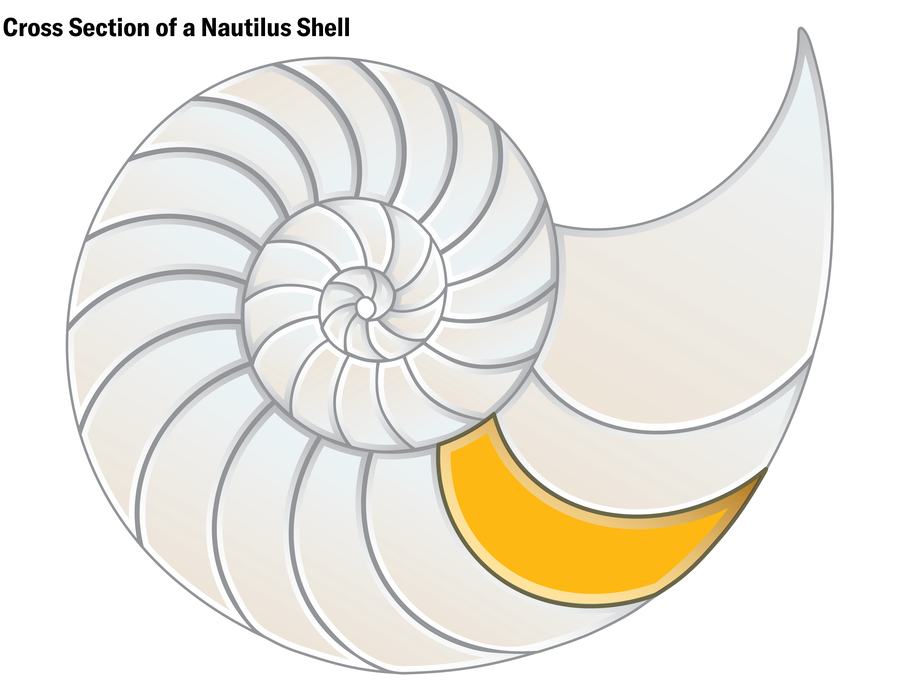
Jen Christiansen; Source: “Soft Cells and the Geometry of Seashells,” by Gábor Domokos, Alain Goriely, Ákos G. Horváth and Krisztina Regős; February 6, 2024; arXiv:2402.04190 (reference)
The idea might have died there if not for a freely available set of micro CT scans published by the D’Arcy Thompson Zoology Museum at the University of Dundee in Scotland. Domokos found the scans online and spent hours “crawling around inside” the shells, looking for corners. He couldn’t find any.
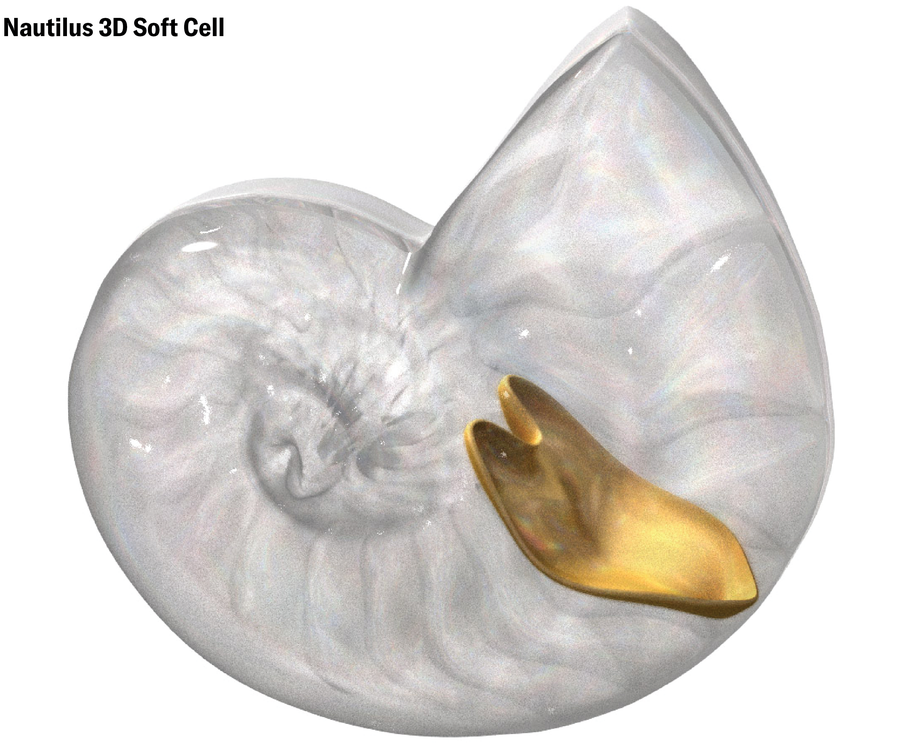
Violet Frances; Source: “Soft Cells and the Geometry of Seashells,” by Gábor Domokos, Alain Goriely, Ákos G. Horváth and Krisztina Regős; February 6, 2024; arXiv:2402.04190 (reference)
No one on the team knew the first thing about shells. But Domokos knew someone who did: Alain Goriely, a physicist and applied mathematician at the University of Oxford who had studied chambered seashells. Domokos was nervous to tell anyone outside his small group about the project, especially now that they’d discovered soft cells inside the nautilus shell—a favorite form among mathematicians fond of natural shapes. It would have been easy to scoop their idea and publish it first. But Domokos had known Goriely for decades, so he decided to take a risk and call him. Not long after, he and Regős were on a plane headed for Oxford.
Goriely was immediately gripped by the discovery of soft cells within the nautilus shell. “I find it is quite natural for shapes in nature to go that way because forming sharp corners is very costly,” Goriely says. Biological cells are soft, and surface tension will naturally round them off unless the organism expends energy to build rigid structures that can hold pointier shapes. And cells within a living thing want to fill space efficiently with few gaps.
In their three frantic days at Oxford and the months that followed, Goriely and the Hungarians identified more and more examples of soft cells in nature and art. Zebra stripes, river estuaries, cross sections of onions, seashells, heads of wheat, red blood cells, plants and fungi all resembled 2D soft cells. And in architecture, 2D soft cells lend futuristic, organic forms to many buildings by architect Zaha Hadid. They also appear in sketches of tatami and clothing by Japanese artist Katsushika Hokusai, who made the famous 1831 painting The Great Wave off Kanagawa, as well as in the art of Victor Vasarely, the “grandfather” of the optical art movement.
Goriely helped the team find another example of 3D soft cells, too: the chambers of ammonite shells. Then Regős concocted a geometric model that produces shapes similar to the seashell examples from first principles. Soft cells like those in the nautilus shell are easily made by intersecting a prism with curved surfaces—an echo of the process Sándor and her team used to design the Cirque du Soleil building. “What’s nice is that architects have intuitively reached that [process] also,” Goriely says. “From our understanding, they’ve reached it with the same types of requirements: they wanted to soften the structure.”
The work establishes a “useful vocabulary” for exploring soft shapes, Goodman-Strauss says—a vocabulary that opens up new mathematical questions. What categories of soft monotiles exist? What groups of soft shapes can and cannot tile space? Domokos wonders how softness relates to aperiodicity, the ability to tile a plane without creating a repeating pattern. The discovery of the first aperiodic monotiles—single shapes that fill space with only copies of themselves but never repeat a pattern—made headlines last year. Domokos and Regős were curious about what would happen if they applied their edge-softening algorithm to the “spectre” tiling, the first truly aperiodic monotile. But they were surprised to discover that its softened version couldn’t tile a plane alone.
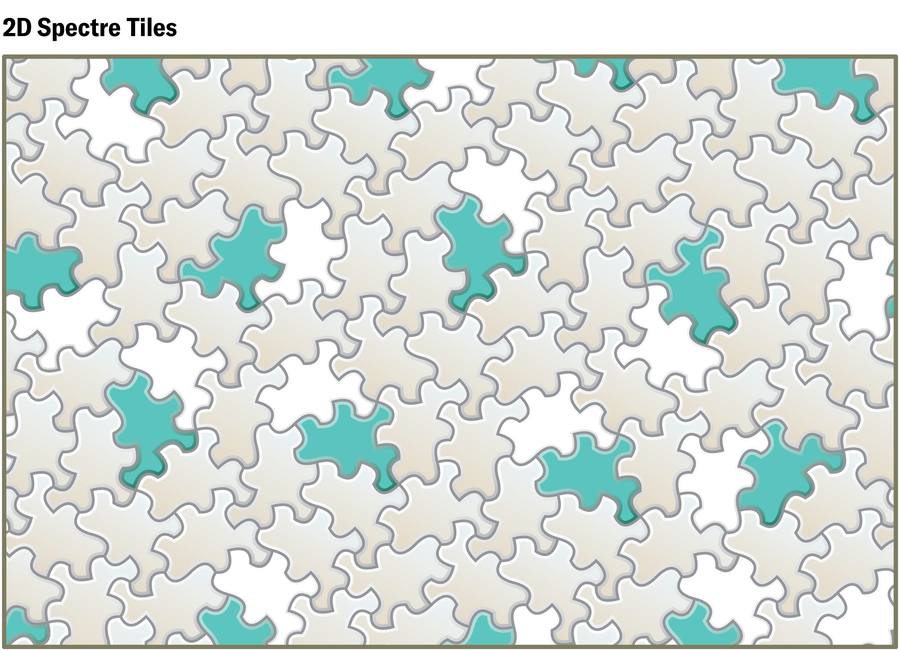
Jen Christiansen; Source: “A Chiral Aperiodic Monotile,” by David Smith, Joseph Samuel Myers, Craig S. Kaplan and Chaim Goodman-Strauss; May 28, 2023; arXiv:2305.17743 (reference)
Arkansas’s Goodman-Strauss and Craig S. Kaplan of the University of Waterloo in Ontario, who both contributed to the discovery of the first aperiodic monotiles, didn’t find it surprising at all. Mathematicians are just starting to explore aperiodic monotiles, and there are many questions left to answer, Kaplan says.
Despite the seeming ubiquity of soft cells in nature, the link between the mathematics of these shapes and biology is, for now, just a visual observation. Domokos admits that this is a weak point of the work and would like to establish the reasons they are so common in nature. “A lot of the paper is about visual similarity, and that’s very unusual,” he says. Exploring this link further appears promising, though, Kaplan says. “I do like the motivation: just the simple claim that nature doesn’t like sharp features, so let’s investigate that from a mathematical perspective. It’s a nice opening gambit from which you can develop a rich theory.”
And the concept of soft cells could turn out to be useful down the line, Goodman-Strauss says—“not necessarily to the biologists of today but the biologists 30 years from now.” Perhaps the mathematics of soft cells will ultimately capture something real about soft matter—the malleable materials that make up most of our world, from the blood in our veins to the liquid-crystal display you might be reading on right now.
Questions about soft geometry are particularly tricky to study because they tend to defy disciplinary boundaries. Domokos struggled for months to find a journal that would publish the team’s “outlandish” manuscript mixing math, art and biology. That’s not surprising to Goodman-Strauss. Asked where he thinks soft cells belong in the scientific landscape, he doesn’t skip a beat. “I think,” he says, “the only answer is it belongs to the future.”

